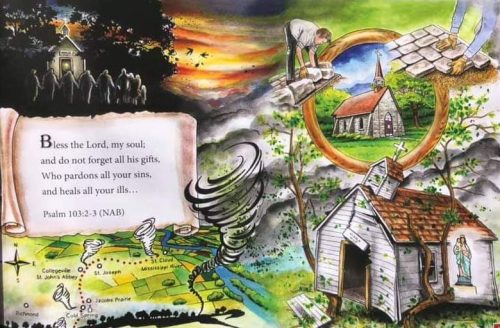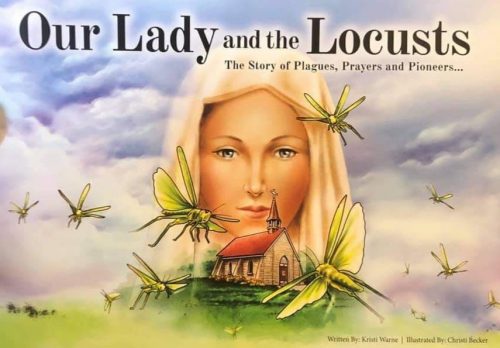Three years ago, Kristi Warne, a parishioner at St. Boniface in Cold Spring, took on new volunteer responsibilities at the nearby Assumption Chapel as the Mass and events coordinator. When she was on the grounds of the Grasshopper Chapel, as it’s sometimes called, visitors would ask about different features and she’d share what she’d read in various articles.
“One question I couldn’t answer was, ‘Why did they pick that hill?’” Warne said. “I went into investigation mode, reading, visiting historical societies and parishes and interviewing the elderly for their memories. It took two and a half years to find that answer — and a plethora of other information as well.”
In her research, she discovered the difficulties facing settlers from the Germanic and Austro-Hungarian regions of Europe and the unique methods they used to end nationwide locust infestations.
When she was done, Warne sought a way to share the stories. She didn’t intend to write a historical book for preteens through adults about Minnesota’s locust plagues during the 1800s. But, after weighing the options, that seemed the best. She started writing, condensing the material, focusing on poetic themes, shortening her text to manage the number of pages she’d budgeted for.
“Because I’m a visual learner, I know pictures get people’s attention and communicate better than words alone, so I made lists and stick drawings of what I needed in those pictures.”
Then she contacted Christi Becker whose artwork she’d seen. Becker, a parishioner at St. James in Jacobs Prairie, paints stained glass for churches and mausoleums, but has worked with a variety of media. Recently, Becker had restored the statue of the Virgin Mary and the Christ Child at Assumption Chapel.
[perfectpullquote align=”right” bordertop=”false” cite=”” link=”” color=”” class=”” size=””]Assumption Chapel is located atop Chapel Hill on Pilgrimage Road, east of Cold Spring. From Highway 23, turn at the stoplights onto Chapel Street, then south on Maple Hill, then right on Pilgrimage Road.[/perfectpullquote]Becker was drawn to the project because the Grasshopper Chapel is special to her and her family.
“I started going there when my kids were young to find peace and serenity, to picnic, to sit and enjoy being there,” Becker said. “I have received blessings from God while praying there.
“Kristi gave me her lists of what she wanted on a single page and I’d figure out how to show that, from left to right. It was very challenging but fun.”
At the same time, Warne kept cutting her text, realizing that Becker’s illustrations would help people imagine themselves in the story. “Because it’s a book of history, I added a timeline and glossary.” Warne said. “Though it deals with the German Catholicism of that time, it’s not intended as a religion book alone.”

Becker’s favorite illustration shows the tornadoes that destroyed the original chapel in 1894. “The tornado dropped the old wooden chapel on oak trees. Those bent trees, more than 100 years old, are still there today,” she said. “On each page is a frame, showing what people were praying for at that time. On that page, in the frame is a new stone chapel.
Barn swallows are featured throughout the book.
“Besides being prevalent around here, and eating locusts and mosquitoes, they’re symbols of preparing,” Becker said. “At the beginning of the book, swallows build a nest. In the middle, eggs are in the nest and, at the end, babies are born. I didn’t know that swallows represented miracles when I put them on the first page but after I was done I looked up the symbolism. It matched perfectly.”
Becker’s illustrations use a combination of watercolor pencil, markers and acrylics, with computer manipulation on the covers.
“In each picture I accentuated beautiful clouds and sky as dramatic life forces — I always focus on the light,” Becker said. “I believe in a divine light in all of us and try to spread that light.”
Warne had initially hoped the book, titled “Our Lady and the Locusts: The Story of Plagues, Prayers and Pioneers,” would be ready for the annual novena at the chapel this May, but it was canceled due to the pandemic. “The coronavirus is a different kind of plague, but God always has a bigger plan. The feast of the Assumption, Aug. 15, was my next choice.
“It’s important,” Warne said, “that we share our faith, our Scripture and our stories. In these days of texting, stories aren’t being told over and over. They aren’t being written down. We learn so much about past generations and families through storytelling.”
Why was that hill chosen for a chapel? You’ll have to pick up a copy of their book to find out.
“Our Lady and the Locusts: The Story of Plagues, Prayers and Pioneers” can be purchased at St. Cloud Bookshop, 320-252-1152; at 23 7th Ave. S., St. Cloud; or at historyforgottenpublishing.com and click on “buy now.” The $19.95 price includes tax and shipping.






















